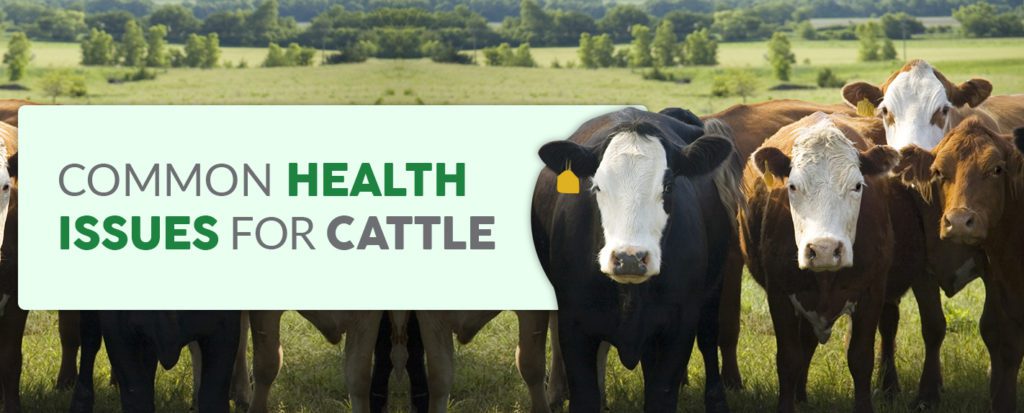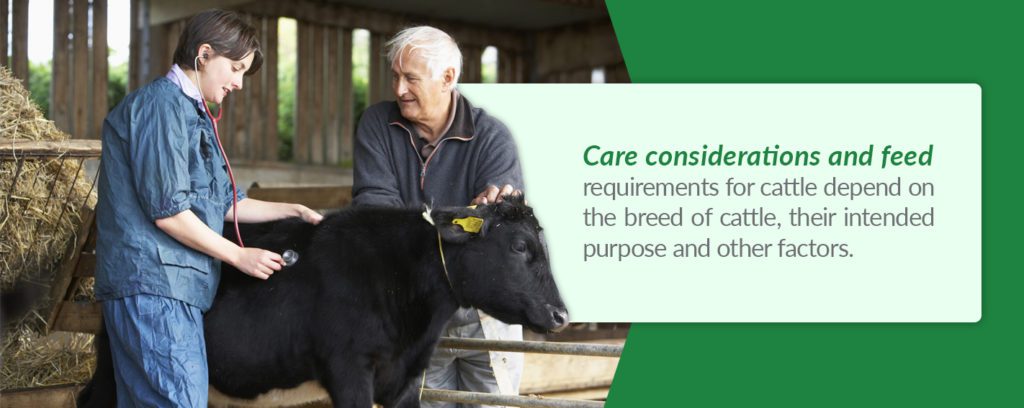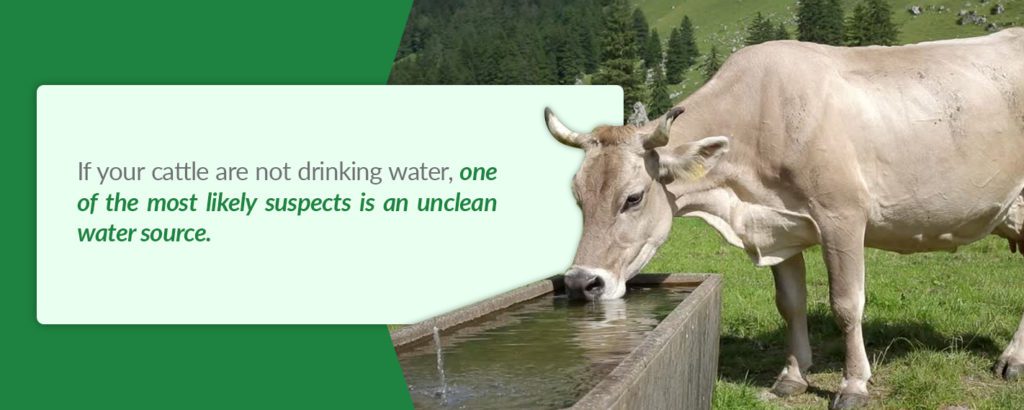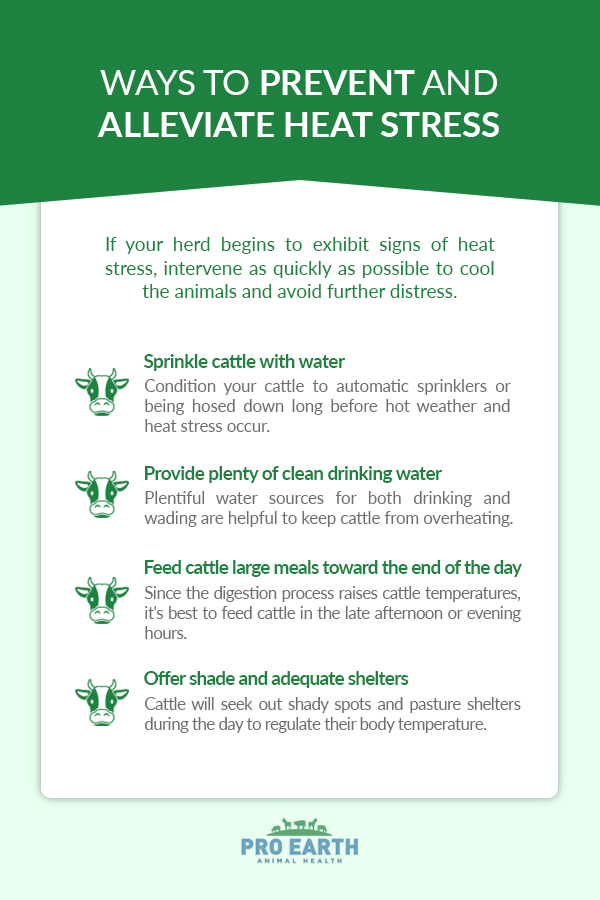Featured
 Due to the physiology and structure of bovines — which is unique in the animal kingdom — cattle health issues are also unique. With their four-chambered stomachs and a surprising susceptibility to heat, cattle require special care, monitoring and handling to maintain optimum health and longevity.
Due to the physiology and structure of bovines — which is unique in the animal kingdom — cattle health issues are also unique. With their four-chambered stomachs and a surprising susceptibility to heat, cattle require special care, monitoring and handling to maintain optimum health and longevity.
Fortunately, there are a few simple ways to improve your herd’s health. Watchful ranchers can detect early signs of the most common cattle health issues, and then take preventative measures to correct potentially detrimental conditions. Understanding how a cow’s digestive system works can help you make informed decisions for improved diets and natural supplements.
Table of Contents
- Determining Needs for Different Types of Cattle
- Bovine Digestion and Appetite
- Reasons Cattle Won’t Eat
- Reasons Cattle Won’t Drink
- Cattle Heat Stress
- How to Tell If a Cow has Heat Stress
- Ways to Prevent and Alleviate Heat Stress
- Common Respiratory Diseases in Cattle
- How CattlActive® Can Improve Your Herd’s Health
Determining Needs for Different Types of Cattle
Care considerations and feed requirements for cattle depend on the breed of cattle, their intended purpose and other factors such as the health, age, gender, milk production and breeding status of individual animals. The geographical region and seasonal weather conditions should also be taken into consideration. Even minimum daily water requirements for cattle should be evaluated regularly according to herd activity levels, pasture size, the height of the pasture grass, shelter and shade availability, the number of animals in the herd and changing environmental conditions.
 Here is a look at how cattle needs vary based on their stage in life and what they will be used for:
Here is a look at how cattle needs vary based on their stage in life and what they will be used for:
- Dairy Cattle: Dairy cattle experience unique stresses from calving and lactating, especially after calving and during the first 21 days of lactation. These stresses can put mothers off their feed — a direct response to lowered pH levels in the rumen due to body stress after calving. High summertime temperatures can also reduce conception rates and hinder milk production.
- Cow and Calf: Like dairy cattle, breeding cattle need special care to maintain optimum body condition and conception rates prior to calving. After calving, cows may be more vulnerable to heat stress. Young calves are also at risk for heat stress, and their undeveloped immune systems leave them more susceptible to common cattle ailments such as acidosis and scours.
- Preconditioners and Feeders: Beef cattle that are destined for the marketplace are generally more susceptible to heat stress symptoms, primarily due to crowded feedlot conditions and higher body scores.
Recognizing the difficulties that certain types of cattle are most likely to face will give you an advantage as a cattle caretaker.
Bovine Digestion and Appetite
Of the four stomach compartments, the rumen is the largest compartment. It can hold more than 25 gallons of feed material for fermentation over time.
The fermentation process in the rumen generates heat inside of the animal for up to six hours after feeding, which is why many experts recommend giving cattle their largest feeding of the day later in the evening — especially during the summer — so that digestion can occur during cooler nighttime hours.
Since cattle are ruminants, they need constant 24-hour access to large quantities of roughage — primarily comprising hay, grass, silage or a combination of all three — to keep their digestive systems active and healthy. How much feed cattle consume daily depends on the quality of the feed and whether the cows are lactating.
On low-quality feed, adult cattle may consume between 1.6% and 1.8% of their total body weight, while lactating cows may consume 2.0% of the same feed per day. On average-quality forage, cattle consumption may increase to an amount between 2.0% and 2.1% of their body weight, while lactating cows may consume 2.3% of their body weight per day. If a medium-sized cow weighs about 1,200 pounds, expect the animal to consume between 28 and 32 pounds of feed daily.
Reasons Cattle Won’t Eat
Digestion issues rank among the most common livestock health problems, and they are typically the result of stress from handling, calving, overheating and overcrowded conditions, among other factors. Here are some of the digestive issues cattle can experience that cause them to go off-feed:
1. Ketosis
Ketosis occurs when cows intake more feed energy than they expend. Pregnant cattle are at their greatest risk for ketosis as they near the end of their gestation period, when calf embryo development is most advanced and energy drain on the mother is at its highest. At that point, pregnant cows become restless and go off their feed.
2. Acidosis
The pH level in the rumen rises and falls daily. Normal pH runs between 6.5 and 7.0. When the rumen pH drops below 6.0 and hovers at 5.6 or less for any length of time, afflicted cattle are at risk for developing a metabolic disease called acidosis.
Feed that is high in carbohydrates — such as barley — is swiftly digested and subsequently causes a cow’s blood sugar levels to spike. Even though acidosis can be a herd-wide problem, it affects each individual animal differently and to varying degrees of severity — based on factors such as age, health, eating patterns, lactation production and breeding status.
There are two types of acidosis cases:
- Sub-Acute Ruminal Acidosis (SARA) may go undiagnosed and usually rights itself without treatment, but cattle that develop SARA once become more prone to repeat episodes and more severe, or acute, cases of acidosis. SARA occurs when pH in the rumen drops to less than 5.8 for even a short period of time, temporarily reducing a cow’s ability to absorb nutrients from feed. Symptoms of cattle with sub-acute acidosis include reduced body condition scores, dehydration from low water retention, abscesses on the liver, whole grains appearing in the manure, and diarrhea (also known as scours).
- Acute Acidosis takes place when pH in the rumen remains low over an extended time period, leading to far more serious health problems in cattle. In a low pH environment, microbes and healthy gut bacteria in the rumen die off, decreasing a cow’s ability to draw nutrients from feed and causing a simultaneous spike in acid production.
Excess stomach acid levels, over and above what cattle need to properly digest feed, becomes dangerous. This excess stomach acid can also damage the delicate rumen lining and allow stomach bacteria to seep into a cow’s bloodstream, leading to shock, sickness and even death.
3. Scours and Calf Scours
Another term for diarrhea in cattle is scours, or enteritis, which references intestinal tract inflammation. Cattle afflicted with scours rapidly dehydrate and lose crucial electrolytes — which are beneficial salts and minerals.
Scours is most often seen in newborn calves, so it is referred to as “calf scours.”
Even if the rest of the herd appears healthy, calves are more fragile and may contract viral scours from manure — especially in overcrowded pasture conditions. Calf scours can also be caused by overindulgence in excess milk — resulting in the ingestion of more milk than the calf’s stomach can properly digest — and ingesting dirt, sand, other foreign objects or solid feeds that upset their delicate digestion systems.
The condition is most common in calves under three weeks old. If left untreated, infected calves suffer from rapid dehydration and hypoglycemia from an inability to absorb nutrients.
Common pathogens that can cause calf scours include:
- Bacteria: Strains of salmonella, Escherichia coli and Clostridium perfringens.
- Viruses: Bovine virus diarrhea (BVD), rotavirus, coronavirus and more.
- Parasites: Cryptosporidium, coccidia and others.
Calf scours can also be the result of poor environmental conditions, such as overcrowding, uncleanliness and malnourishment.
Reasons Cattle Won’t Drink
Daily water requirements for cattle usually run high and vary based upon age, environmental and pasture conditions, seasonal weather and the outdoor temperatures, as well as other factors. The daily water requirements for lactating cows are higher still, as they need to consume at least three times the water in relationship to the amount of milk they produce — in addition to their usual daily water intake. One cow can drink between three and 30 gallons of water per day.
If your cattle are not drinking water, one of the most likely suspects is an unclean water source. Urine and dung can find their way into ponds and streams on the pasture land, and cattle may refuse to drink contaminated water.
 Also, if the local water tastes strange to cattle for any reason, they will avoid drinking to instinctively reduce the risk of parasites, bacteria and other harmful organisms. Even clean water may have an odd taste to transplanted or transported cattle that are accustomed to a different water flavor, and they may choose not to drink. Low water intake will leave cattle more prone to subsequent dehydration and conditions such as heat stress.
Also, if the local water tastes strange to cattle for any reason, they will avoid drinking to instinctively reduce the risk of parasites, bacteria and other harmful organisms. Even clean water may have an odd taste to transplanted or transported cattle that are accustomed to a different water flavor, and they may choose not to drink. Low water intake will leave cattle more prone to subsequent dehydration and conditions such as heat stress.
Here are a few ways to encourage your cattle to drink enough water:
- Provide fresh drinking water in troughs. Containing the drinking water in troughs ensures the cattle’s water source will not be subject to waste contaminants or leached urine and cow manure. If the herd includes calves, be sure to provide shallow troughs to give them access to clean water as well. Even though calves derive much of their hydration from their lactating mothers, water is essential to proper rumen development in young calves.
- Frequently change water or provide running water in troughs. Changing the water and cleaning the water troughs on a regular basis keeps parasites and other organisms from contaminating the water supply. Providing a source of running water for cattle keeps the water oxygenated and deters insects from laying eggs, as hatching larvae require an environment with stagnant pools or standing water.
- Ensure plenty of troughs to accommodate cattle. Larger and more dominant cattle will bully smaller or more submissive animals out of their personal space, which makes it harder for shy cattle to maintain optimum hydration levels and increases herd stress. Experts recommend a provision of approximately 30 feet of trough space per 100 cattle, and they also suggest placing several water troughs in multiple locations for more comfortable watering accommodations.
- Break the ice. Cattle require water in the winter months — as well as during summer heat waves. When the mercury drops below freezing, check water troughs regularly to ensure they are free of ice.
Cattle Heat Stress
When the Temperature Humidity Index (THI) rises over 80 degrees, cattle will begin to exhibit signs of heat stress. Just three days of exposure to high temperatures can put your cattle herd at significant risk for heat stress, especially during the summer months. But multiple factors cause cattle to suffer from heat stress, which can lead to problems that range from a negative impact on fertility to potential fatality.
Since cattle do not sweat as well as other types of animals, cattle rely on respiration — rather than sweat — to cool their bodies. While all cattle should be monitored for signs of heat stress, certain kinds of cattle are more susceptible to heat stress. Cattle at greater risk for heat stress include:
- Heavier cattle. Heavier cattle and cattle with larger body structures do not disperse heat as well as lighter or smaller cattle. Layers of fat insulate cattle and prevent their bodies from releasing heat.
- Feedlot cattle. Since cattle that are raised for the marketplace generally have heavier body scores combined with decreased lung capacity, feedlot cattle have a weakened ability to cope with environmental stresses such as high temperatures.
- Cattle with respiratory problems. Since cattle cool their bodies through respiration rather than perspiration, cattle that suffer from respiratory issues are naturally at greater risk for heat stress. If cattle are compromised by weakened immune systems or respiratory diseases, they fall prey to heat stress more easily.
- Very young calves and old cattle. The respiratory systems of young cattle are underdeveloped and more easily overwhelmed by heat. Due to strain on their respiratory systems from age, old cattle are also at greater risk of succumbing to heat stress.
- Cattle housed in smaller enclosures or feedlots. Pastured cattle have the ability to seek shade and areas of greater airflow than cattle on feedlots, whereas cattle in smaller enclosures experience shared body heat from being packed too closely together. In addition, pastures — especially those with tall grass — provide cattle with a cooler ground environment. Feedlots or small enclosures with packed dirt or concrete surfaces absorb heat and radiate it back to the animals, increasing the probability of heat stress.
- Cattle with black hides. Since black hides absorb heat, black or dark-colored cattle typically have a body temperature that is two degrees higher than cattle with lighter-colored hides — leaving them more vulnerable to heat stress. Fatality rates are higher among black cattle than other colors of cattle.
- Cattle with inadequate water supply. During periods of heat stress, cattle will increase their water intake considerably to cool their bodies — since they cannot sweat as well as other types of animals. They may also wade into available bodies of water to bring their internal temperatures down. Providing sources of clean water for drinking and bathing, especially during the summer months, is essential to preventing heat stress in the herd.
How to Tell If a Cow has Heat Stress
The first sign of heat stress is that cattle will slow or cease feeding, which is an instinctive attempt to lower a raised core temperature. This is followed by restless behavior and the herd moving together as a group. Water consumption will significantly increase.
Cattle undergoing heat stress will also experience increased heart rates in an effort to cool the blood through circulation, which places considerable strain on their cardiovascular system. In severe stages, distressed cattle will slobber and drool, then exhibit rapid respiration with open-mouthed panting and labored breathing in a desperate attempt to cool down.
If no steps are taken to remedy these symptoms, heat-stressed cattle may die.
Ways to Prevent and Alleviate Heat Stress
Taking measures to prevent conditions that could lead to heat stress will spare both you and your cattle a lot of trouble. If your herd begins to exhibit signs of heat stress, intervene as quickly as possible to cool the animals and avoid further distress.
 Here are a few ways to protect your cattle from heat stress and ease heat stress symptoms:
Here are a few ways to protect your cattle from heat stress and ease heat stress symptoms:
- Sprinkle cattle with water. Since the stress of handling can be detrimental to heat stress relief efforts, condition your cattle to automatic sprinklers or being hosed down long before hot weather and heat stress occur. When sprinkling cattle with water, it’s important to cool the animals down gradually to avoid temperature shock. Avoid the use of very cold water.
- Provide plenty of clean drinking water. Where possible, provide ponds or other bodies of water for wading as well as drinking. Plentiful water sources for both drinking and wading are helpful to keep cattle from overheating.
- Feed cattle large meals toward the end of the day. Since the digestion process raises cattle temperatures, it’s best to feed cattle in the late afternoon or evening hours. Later feedings keep cattle from battling the sun during the hottest part of the day while sweltering from digestion.
- Offer shade and adequate shelters. Cattle will seek out shady spots and pasture shelters during the day to regulate their body temperature.
Common Respiratory Diseases in Cattle
Bovine Respiratory Disease (BRD), or Bovine Respiratory Disease Complex (BRDC), serves as an umbrella category for a variety of respiratory viruses and bacteria that can cause pneumonia and death, especially in calves. BRD is also known as “Shipping Fever,” due to the propensity for cattle — especially very young and particularly underweight calves — to contract respiratory illnesses after transport and containment on crowded feedlots.
Several types of infectious pathogens — bacteria, viruses and parasites — can lead to BRD, such as
- Bovine respiratory syncytial virus (BRSV)
- Bovine herpes virus (IBR)
- Bovine parainfluenza Virus (PI-3)
- Bovine diarrhea virus (BVD)
- Bovine coronavirus (BCV)
- Mannheimia haemolytica
- Pasteurella multocida
- Mycoplasma bovis
- Histophilus somni
- Lungworm
These bacteria can sometimes be found in the nasal passages of healthy cattle, however, so for cattle to develop BRD, several other factors come into play as well. These include age, the strength of the animal’s immune system, stress levels and nutrition, among others.
Typical symptoms of BRD include:
- Difficulty breathing
- Rapid, shallow breathing
- A fever that is higher than 104 degrees Fahrenheit
- Reduced appetite or no appetite
- Nasal discharge
- Coughing
- Various levels of depression
How CattlActive® Can Improve Your Herd’s Health
CattlActive® is an all-natural probiotic supplement that provides your cattle with essential vitamins and minerals, promotes strong gut health and helps fight against factors that cause scours and other digestive issues as well as respiratory distress.
Here are just a few of the benefits of CattlActive®:
- Boosts the immune system
- Promotes healthy gut microbiota
- Improves digestion and nutrient absorption
- Quickly neutralizes excess stomach acid, balances ruminal pH and lowers rumen temperature
- Improves the quality of cow’s milk for healthier calves
- Reduces stress from factors such as heat, handling and travel
- Improves hydration levels and proper water retention
To find out more about CattlActive®, contact us online. One of our knowledgeable and friendly staff members will answer your questions and help you find the best solution for your herd. We also carry Zesterra®, a supplement specially formulated for horses and other members of the equine family.
